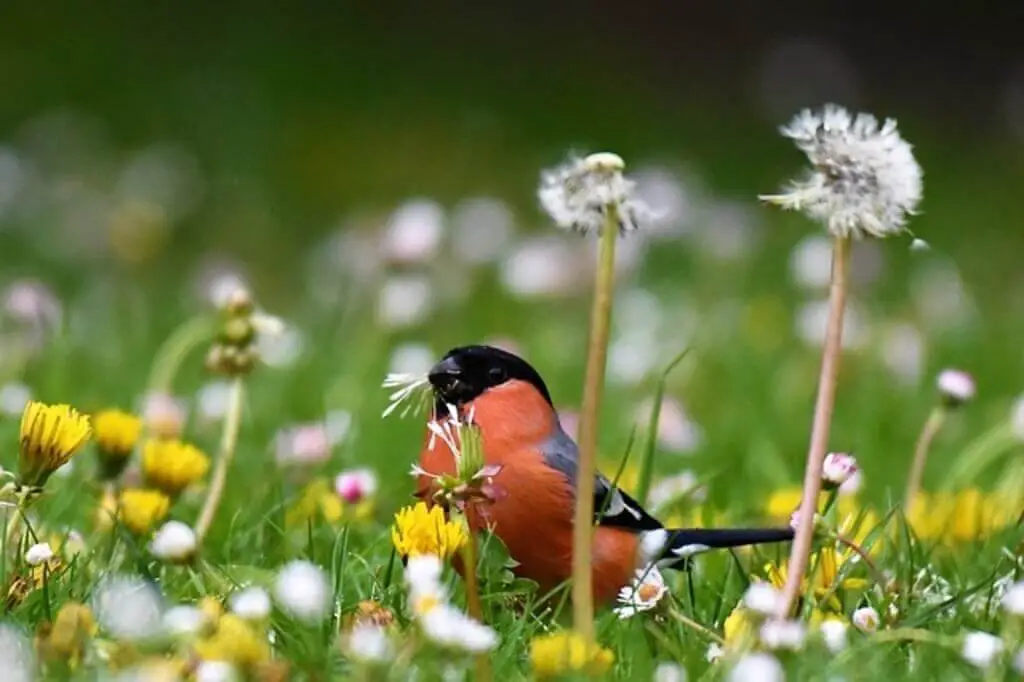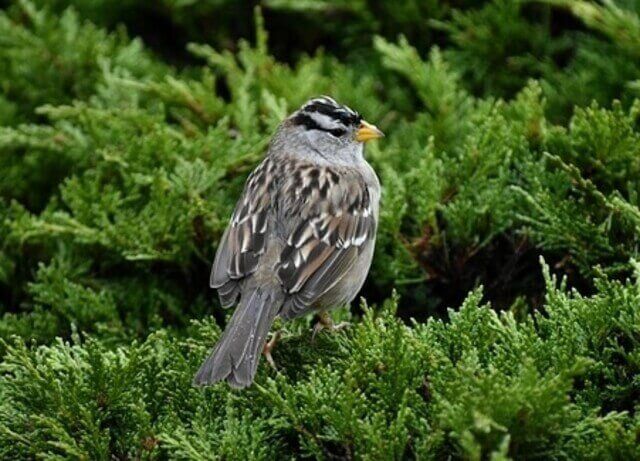During the spring, a familiar sight is the delicate white tufts of dandelion seeds gracefully drifting through the air, carried away by the breeze. In this article, we’ll delve into the intriguing dietary preferences of 14 birds that eat dandelion seeds.
There are a variety of bird species in North America, and all of them have their own unique eating habits. Some eat bugs exclusively, while others feast on fruits and berries. However, one particular food is quite popular among many types of birds: dandelion seeds!
Table of Contents
Pine Siskin
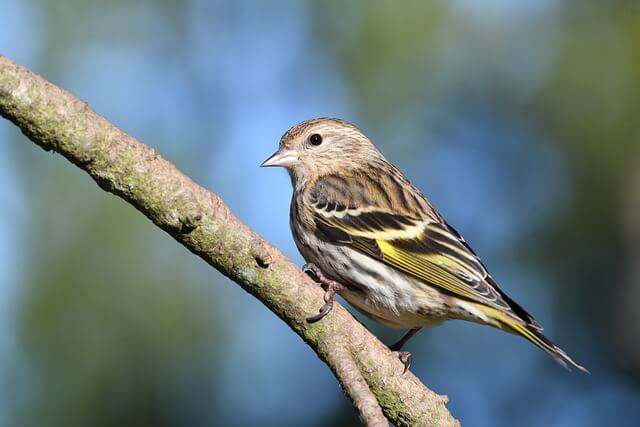
- Length: 4.3-5.5 in (11-14 cm)
- Weight: 0.4-0.6 oz (12-18 g)
- Wingspan: 7.1-8.7 in (18-22 cm)
The Pine Siskin, a diminutive songbird native to North America, thrives predominantly in forested habitats. Their diet comprises a diverse range of elements, including insects, seeds, fruits, and various plant materials. Notably, they exhibit a unique feeding behavior by extracting dandelion seeds from the fluffy heads of the flowers through precise pecking actions with their beaks.
Indigo Bunting
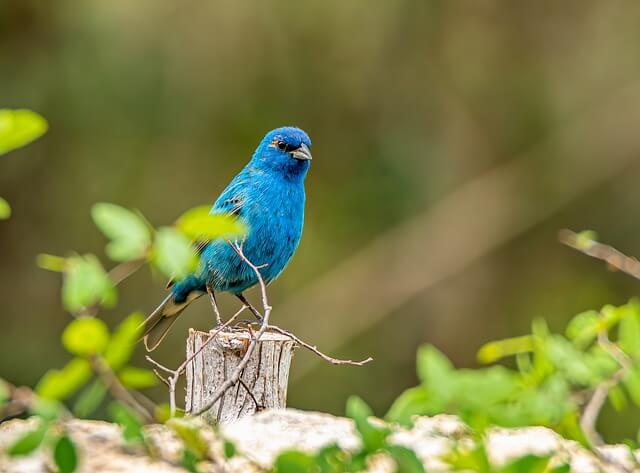
- Length: 4.7-5.1 in (12-13 cm)
- Weight: 0.4-0.6 oz (12-18 g)
- Wingspan: 7.5-8.7 in (19-22 cm)
The Indigo Bunting, a diminutive songbird native to North America, has a fondness for dandelion seeds. They indulge in this dietary preference during the springtime when these seeds are abundant. Finding sustenance during this season can be challenging, given the typically cold weather and the limited growth of plants. These resilient little birds patiently await the return of their beloved dandelions before embarking on a season of uninterrupted feasting!
Pine Grosbeak
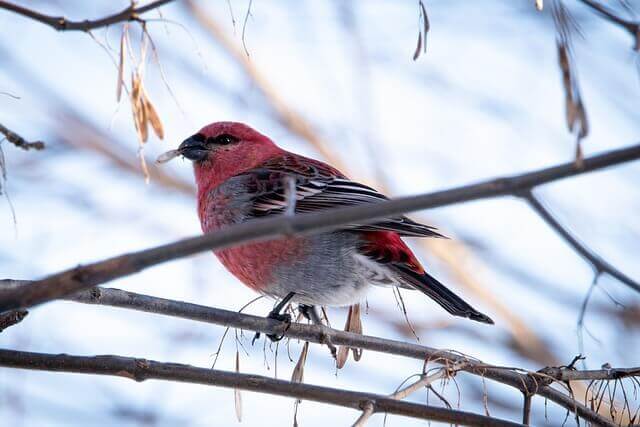
- Length: 9.3 – 10.0 in. (23 – 25.4 cm)
- Weight: 1.8 to 2.8 oz. (52 to 78 g)
- Wingspan: 12.0-13.0 in. (30.5-33.0 cm)
Pine Grosbeaks frequently indulge in dandelion seeds, deftly pecking the seed heads to access the nourishing contents within. While dandelions rank high among their favored foods, their culinary preferences extend beyond. These versatile birds also relish fruits such as cherries, grapes, and apples, savor insects like grasshoppers and crickets, and are even known to opportunistically consume bird eggs!
Common Redpoll
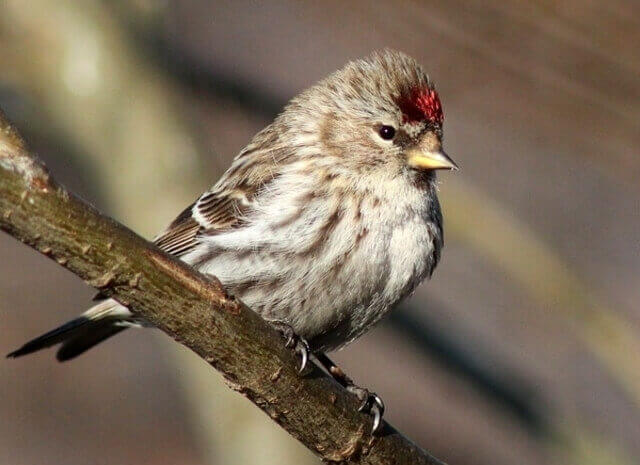
- Length: 4.7-5.5 in (12-14 cm)
- Weight: 0.4-0.7 oz (11-20 g)
- Wingspan: 7.5-8.7 in (19-22 cm)
Common Redpolls, a migratory avian species, primarily inhabit Canada and the northern regions of the United States. These petite birds exhibit a unique affinity for dandelion seeds, drawn to the vibrant yellow flowers that transform into delicate, cottony spheres after pollination by insects. When their moment for sustenance arrives, these birds diligently seek out clusters of dandelion plants, where they indulge in a feast of seeds.
American Goldfinch
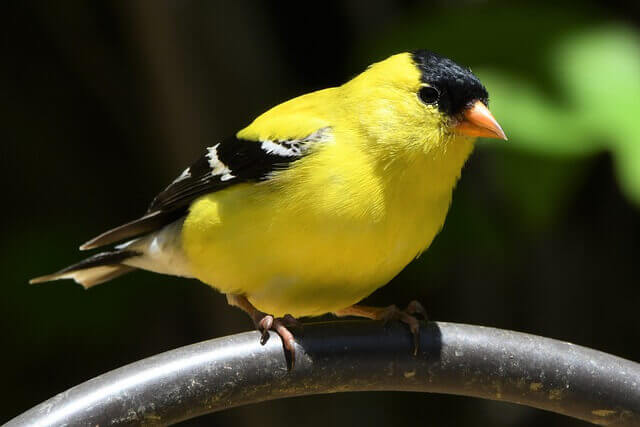
- Length: 4.3-5.1 in (11-13 cm)
- Weight: 0.4-0.7 oz (11-20 g)
- Wingspan: 7.5-8.7 in (19-22 cm)
The American Goldfinch, a diminutive and widespread bird species in North America, exhibits a strong affinity for dandelion seeds as a primary food source. On average, these charming birds consume approximately 2000 of these minuscule seeds daily. Observers frequently witness them foraging for these seeds on the ground and within lawns, while they adeptly employ their beaks to excavate hidden treasures from soil patches.
Eurasian Bullfinch
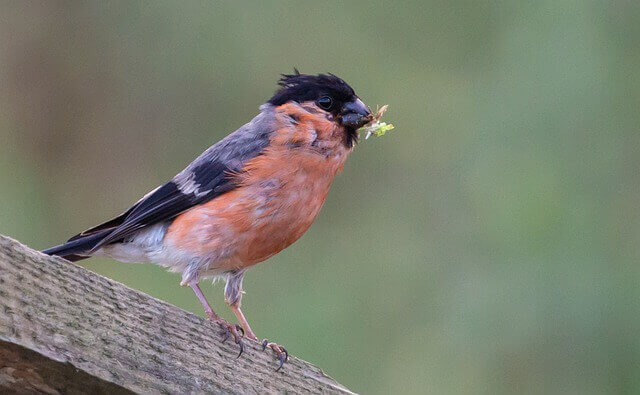
- Length: 5.9-6.7 in.(15-17 cm)
- Weight: 0.7-0.8 in.(21-23 g)
- Wingspan: 8.3-9.8 in.(21-25 cm)
The Eurasian Bullfinch, a petite passerine bird in the finch family, is a resident of Europe and certain regions in Asia. These colorful birds sustain themselves on a diet comprising seeds, fruits, and insects. Sadly, their population has witnessed a steady decline over the years, primarily attributed to habitat loss, diminishing food sources, and climate fluctuations. During the breeding season, dandelions play a vital role in their diet, serving as a crucial food source when other options are scarce.
Common Linnet
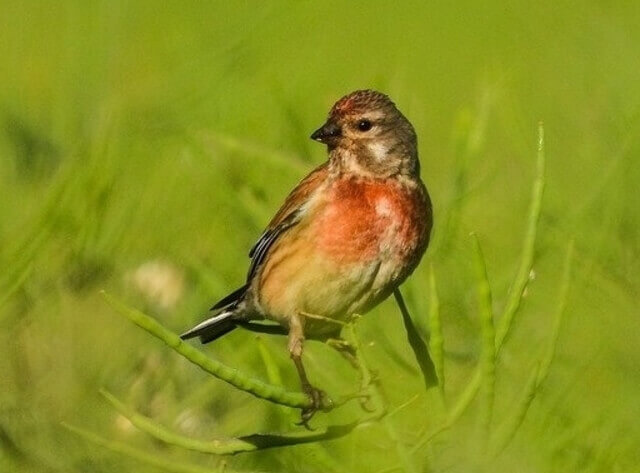
- Length: 5.3-5.5 in.(13.5-14.0 cm)
- Weight: 0.5-0.9 in.(15-26 g)
- Wingspan: 8.3-10.0 in.(21.0-25.5 cm)
The Common Linnet, a petite songbird belonging to the finch family, is distributed across Europe, the Palearctic region, North Africa, and Asia. These charming birds have a varied diet, often relying on weeds to obtain the necessary protein for feather growth. Dandelions are a frequent choice among their dietary options, but they are also known to feed on thistles, daisies, sunflower seeds, burdock, sorrel, and plantains. The composition of their diet may shift seasonally based on food availability.
White-crowned Sparrow
- Length: 5.9-6.3 in (15-16 cm)
- Weight: 0.9-1.0 oz (25-28 g)
- Wingspan: 8.3-9.4 in (21-24 cm)
White-crowned Sparrows, as songbirds, exhibit a preference for dandelion seeds as part of their diet. These avian residents are primarily found in North America, with abundant populations spanning across Canada and certain regions of the United States. While their usual diet consists of insects, they readily include dandelion seeds when resources are limited, making them a resourceful forager as they journey through your yard in search of nourishment.
House Sparrow
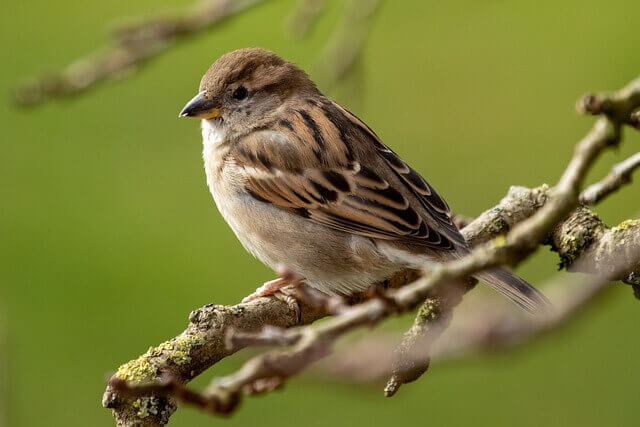
- Length: 5.9-6.7 in (15-17 cm)
- Weight: 0.9-1.1 oz (27-30 g)
- Wingspan: 7.5-9.8 in (19-25 cm)
Dandelion seeds are an excellent source of food for house sparrows. Dandelion seeds contain lots of vitamins and minerals that help with digestion, which is why they make such a good meal for birds. House sparrows will eat the whole seed: the inside, called the endosperm, as well as the hull or shell around it. House sparrows usually store these extra seeds in their crops (a section of their stomach) before swallowing them to digest later.
Chipping Sparrow
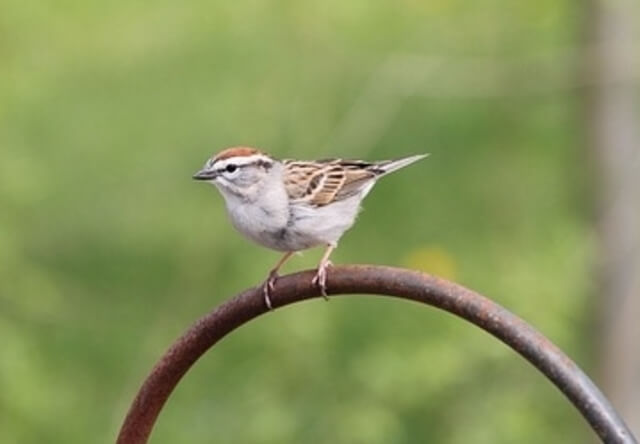
- Length: 4.7-5.9 in (12-15 cm)
- Weight: 0.4-0.6 oz (11-16 g)
- Wingspan: 8.3 in (21 cm)
Chipping Sparrows are a prevalent bird species across North America, typically inhabiting open landscapes like grasslands and meadows. When foraging, these sparrows employ a straightforward technique known as “bouncing,” wherein they hop between perches until they locate their desired food. While Chipping Sparrows favor dandelion seeds, their diet is versatile, encompassing a range of seeds and insects.
Northern Bobwhite Quail
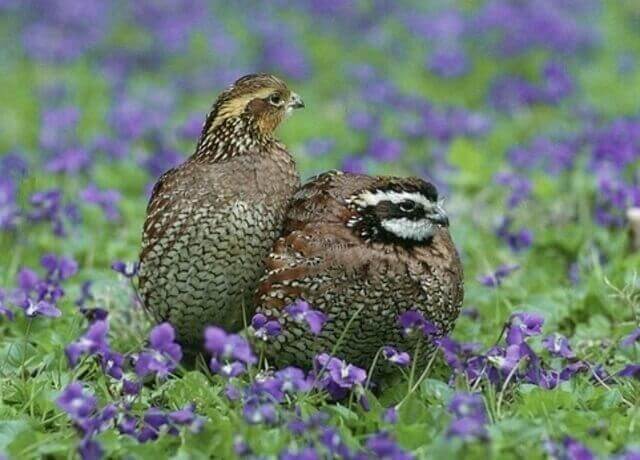
- Length: 9.4 to 11.0 in. (24-28 cm)
- Weight: 4.9-6.0 oz (140 to 170 g)
- Wingspan: 13.0-15.0 in. (33-38 cm)
Dandelion seeds are an important part of the diet for Northern Bobwhite Quail. They rely on dandelions as a food source when other foods such as berries and insects are scarce. The nutritional value of dandelion seeds for the northern bobwhite quail is substantial. The benefits include high levels of protein and unsaturated fats, which can be used as sources of energy for survival during times when their normal diet is not available.
Ruffed Grouse
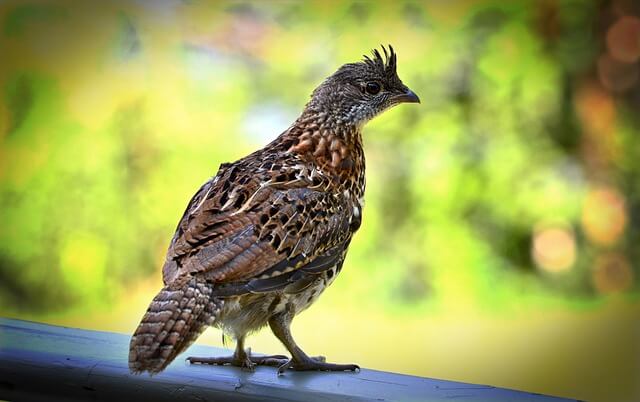
- Length: 16.0-19.7 in (40.6-50 cm)
- Weight: 16.0-26.5 oz (453.6-751.3 g)
- Wingspan: 19.5-25.5 in (49.5-64.8 cm)
During the breeding season, when resources are scarce and the demands are high, Ruffed Grouse incorporate dandelion seeds into their diet to fuel nest-building and mating. Their primary sustenance consists of insects, worms, fruits, and plants. When not engaged in reproductive activities, they graze on grasses like wheatgrass, corn fields (where permitted), and unharvested soybean fields. A study revealed that Ruffed Grouse typically consume approximately 10% of their diet in the form of seeds.
Wild Turkey
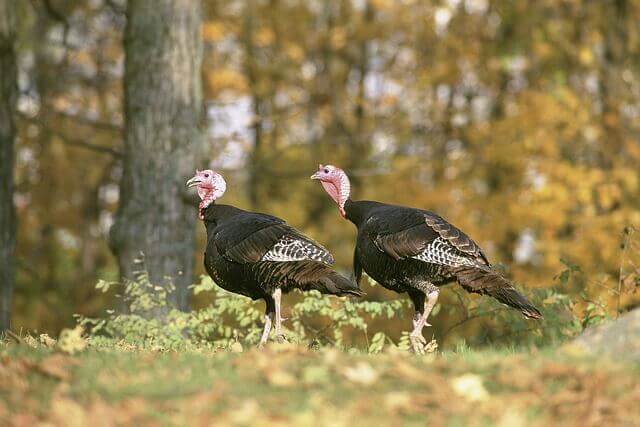
- Length: 43.0-45.5 in (109.2-115.6 cm)
- Weight: 88.0-381.0 oz (2500-10800 g)
- Wingspan: 49.0-57.0 in (124-144.8 cm)
Wild turkeys exhibit remarkable dietary diversity, consuming not only acorns, grasses, berries, mushrooms, and various plants but also insects and earthworms. Surprisingly, their menu includes dandelion seeds, with observations revealing their preference for foraging these seeds during the April to June. This unexpected addition to their diet highlights the adaptability of wild turkeys and their ability to find sustenance in a wide range of natural offerings, showcasing their role as opportunistic omnivores.
Conclusion
In conclusion, birds that include dandelion seeds in their diet demonstrate the incredible adaptability and resourcefulness of avian species. Dandelion seeds, often overlooked by many, serve as a valuable source of sustenance for these birds during certain seasons.
This dietary choice not only highlights the diverse array of foods birds can utilize, but also emphasizes their crucial role in maintaining ecological balance by contributing to seed dispersal.
The inclusion of dandelion seeds in their menu offers a fascinating insight into the intricate relationships between birds and their environment, showcasing nature’s ability to find unexpected connections within the web of life.

